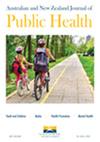Cancer control measures have prevented 230,000 deaths in Australia since the mid-1980s
IF 2.4
3区 医学
Q2 PUBLIC, ENVIRONMENTAL & OCCUPATIONAL HEALTH
Australian and New Zealand Journal of Public Health
Pub Date : 2025-08-01
DOI:10.1016/j.anzjph.2025.100252
引用次数: 0
Abstract
Objective
To estimate the lives saved because of cancer control measures implemented in Australia, since age-standardised mortality rates (ASMRs) have been available.
Methods
Secondary data analysis using publicly available data. We estimated ASMRs using the (unadjusted) age-specific rates and the corresponding population counts. We also estimated the expected number of cancer deaths, the number of avoided cancer deaths and standardised mortality ratios (SMR).
Results
The overall ASMR for females peaked in 1985 at 116.50 per 100,000 (95% CI: 114.40, 118.60) and declined to 81.36 (95% CI: 80.24, 82.48) in 2018. For males, the overall ASMR peaked at 188.27 per 100,000 in 1987 (95% CI: 185.38, 191.16), declining to 116.08 per 100,000 (95% CI: 114.67, 117.48) in 2018. We estimated that 66,733 and 164,358 cancer deaths have been avoided for females and males, respectively. This corresponds to an 11% (SMR = 0.89, 95% CI: 0.89, 0.89) and 20% (SMR = 0.80, 95% CI: 0.80, 0.80) reduction in overall cancer mortality.
Conclusions
When considering overall cancer rates, over 230,000 cancer-related deaths have been avoided in Australia since 1950.
Implications for Public Health
These estimates demonstrate the value of sustained cancer control investment, particularly in primary and secondary prevention.
自20世纪80年代中期以来,癌症控制措施使澳大利亚避免了23万人死亡。
目的:估计由于澳大利亚实施的癌症控制措施挽救的生命,因为年龄标准化死亡率(ASMRs)已经可用。方法:利用公开资料进行二次资料分析。我们使用(未经调整的)年龄特异性比率和相应的人口计数来估计asmr。我们还估计了预期癌症死亡人数、避免癌症死亡人数和标准化死亡率(SMR)。结果:女性总体ASMR在1985年达到峰值,为116.50 / 10万(95% CI: 114.40, 118.60), 2018年下降至81.36 (95% CI: 80.24, 82.48)。对于男性,总体ASMR在1987年达到188.27 / 10万的峰值(95% CI: 185.38, 191.16), 2018年下降到116.08 / 10万(95% CI: 114.67, 117.48)。我们估计,女性和男性分别避免了66,733例和164,358例癌症死亡。这相当于总体癌症死亡率降低11% (SMR = 0.89, 95% CI: 0.89, 0.89)和20% (SMR = 0.80, 95% CI: 0.80, 0.80)。结论:考虑到总体癌症发病率,自1950年以来,澳大利亚避免了超过23万例癌症相关死亡。对公共卫生的影响:这些估计表明持续的癌症控制投资的价值,特别是在一级和二级预防方面。
本文章由计算机程序翻译,如有差异,请以英文原文为准。
求助全文
约1分钟内获得全文
求助全文
来源期刊

Australian and New Zealand Journal of Public Health
医学-公共卫生、环境卫生与职业卫生
CiteScore
4.20
自引率
5.70%
发文量
121
审稿时长
6-12 weeks
期刊介绍:
The Australian and New Zealand Journal of Public Health (ANZJPH) is concerned with public health issues. The research reported includes formal epidemiological inquiries into the correlates and causes of diseases and health-related behaviour, analyses of public policy affecting health and disease, and detailed studies of the cultures and social structures within which health and illness exist. The Journal is multidisciplinary and aims to publish methodologically sound research from any of the academic disciplines that constitute public health.
 求助内容:
求助内容: 应助结果提醒方式:
应助结果提醒方式:


